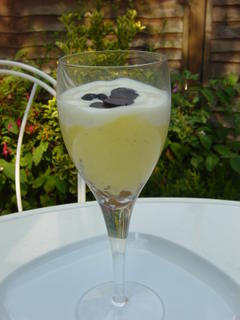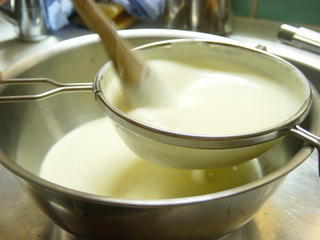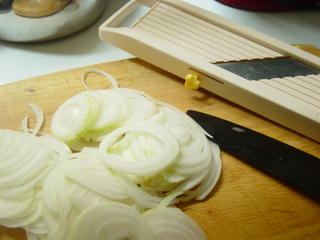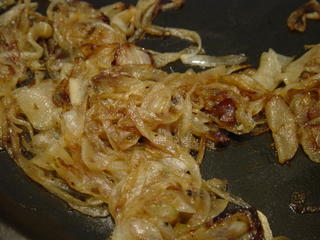
The intermediate term in the kitchen has started with a bang! Blancs and I have been playing around with some of Ferran Adría’s cooking books lately. I think that this is either Blanca’s way of improving my Spanish or scaring me out of the kitchen. Given that she did a stage before at El Bulli Hotel she has a bit of an advantage, but I have sheer bald-faced stupidity on my side.
When dealing with such a superstar chef, where better to start than with one of his iconic dishes. Ferran has made his name as the king of all things "unusual" in the kitchen. He is credited with bringing the foam (espuma) into the commercial kitchens. Methinks with an ironic style, his books attempt to bring the foams into domestic kitchens. Whilst Blancs prefers his classic (and very much out of print) “Concinar en 10 Minutos”, we cooked from “El Bulli: 1998 – 2002”. This is the dark hardcover book that you will find in good bookstores.
There are a few things to understand before we get into the recipe.
What is deconstruction?
In what I believe to be his best book; “Los Secretos de El Bulli”, Ferran explains the prior to 1993, 3 techniques were used to create meals: adaptation, association and inspiration. After 1993 he focused on deconstruction. Basically, it ”uses (and respects) the harmonies already known, transforming the textures of the ingredients, such as form and temperature”. It should retain the ingredients and flavours, but change the textures. Typically, the name of the dishes will remain the same.
What’s an example of deconstruction?
Well, we’re about to look at an example of deconstruction. Everyone knows the classic Spanish omelette; eggs added to olive oil fried potatoes and onion and served upside down. Ferran puts a spin on this, he foams potato mash and layers this over onion and a sabayon of egg yolks.
What’s the deal with foams?
Foams is one of the techniques that allows Ferran produce different textures and techniques. It is an extension of the mousse, with the basic difference that cream and eggs are not necessarily required. Ferran appears to have shares in iSi; he takes every opportunity to recommend their siphon to achieve a pure flavour of foam. He lists the benefits of foams as follows:
- More flavour. As mentioned above, with less lactic products and eggs, the foams hold only the main ingredient flavour.
- Better health value. All fruit or vegetable vitamins and proteins are served intact. There are no additional fats.
- Lighter. The pressured incorporation of air (nitrous oxide) produces a lighter end product.
- Better conservation. The siphon is hermetically sealed and thus preserves food better.
- More economic. Eh, this is kind of questionable. Ok you don’t need extra eggs and cream, but you do need to buy a fairly pricey siphon and gas refills.
- More creative. Also questionable, but undoubtedly, the foam is somewhat more flexible than traditional mousses.
1 iSi siphon
250 g potato
100 ml water from boiled potatoes
3 tbsp olive oil
100 ml cream
Salt
Bring the potatoes to the boil and simmer until cooked. Decant 100 ml of the boiling water before discarding the remainder. Briefly mash the potatoes. Put all the ingredients into a container for blending. Blend until creamy. Season according to taste (we also added pepper).

Sieve in order to remove any lumps that could block the siphon. Be careful here not to press too hard.
Pour the sieved mash into the siphon while still hot. Charge the siphon with nitrous oxide gas. Upturn once or twice after charging. We actually used 3 charges of gas, but, depending on the age, you should get away with 2.
Place the siphon in a bain marie at a similar temperature until ready to use.
2 medium onions
2 egg yolks
1 black truffle
Olive oil

Cut the onions as fine as possible. I used a mandolin for the first time; definitely worthwhile.

Put into an olive oil pan over a low heat and cook until well golden. Note: you can add water / salt in order to prolong the cooking without drying out the onions too much.

Create an emulsion of egg yolk by adding 2 tbsp of warm water and beating until it holds small channels for a short period of time.
To serve
Cocktail glasses are best, but I discovered that all of ours are broken. Wine glasses are best. Put a little of the onion at the bottom of the glass. Put the sabayon on top. Gently apply the foam. This was tricky; it relies on the sabayon being firm enough and the foam being light enough. It is best to hold the nozzle vertical and release the foam until it is at an appropriate level. Top with finely sliced truffle.
The verdict… I’ve had a yoghurt foam before and that was incredible. I wasn’t astounded by the tortilla, but it definitely was different. It lacked a little flavour and I probably used an olive oil that was too cheap (the taste was quite strong). Either way, definitely worthwhile and something that I will try and do a variation on in the future.
I’m thinking deconstructed Irish Stew…




5 comments:
Great post!
such a cute idea, you can imagine people thinking "what the" when you served it too them :)
Posted by clare eats
Hi Steve,
this is gaia from Milan, Italy! I was surfing between the thousands food blogs on the net, and i found yours...it's really nice, i do like all the pics you posted and the way you explain the recipes!
bye bye,
gaia
Posted by Gaia
Hi Steve,
This is Fernando from Miami, Florida. I was looking siphon or similar gadget to make the espumas when I found your blog. Thanks to your information.
Fernando
Posted by Fernando
This is a great gadget!
I bought mine from http://www.SyphonKing.com/
=)
We bought a iSi Gourmet Whip recently, and the 21st century tortilla is definitely one thing to try soon. Thank you for great step-by-step photos!
Post a Comment